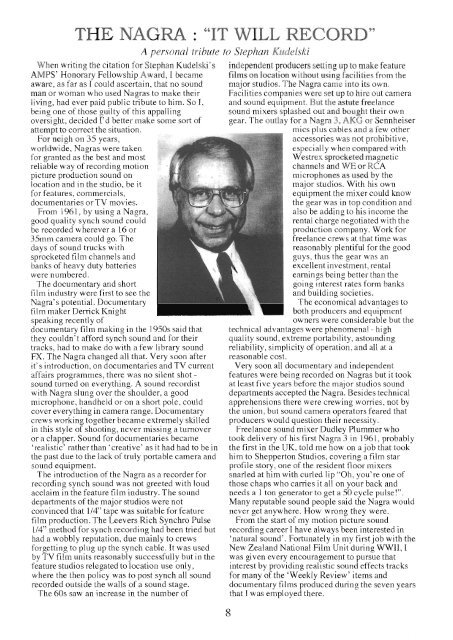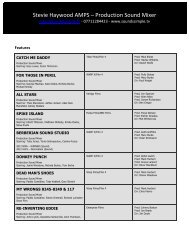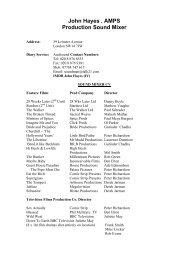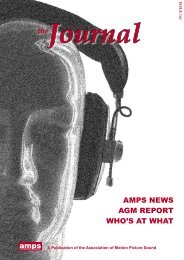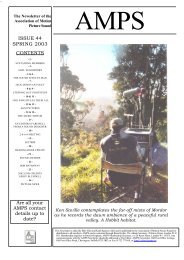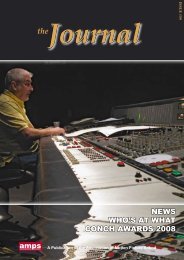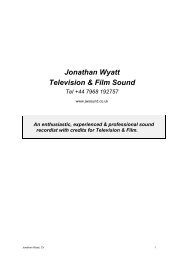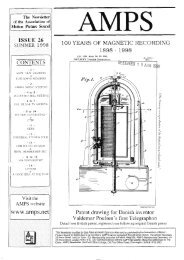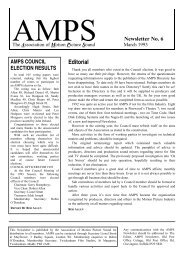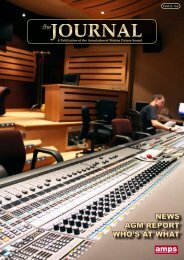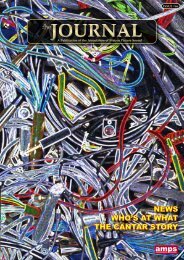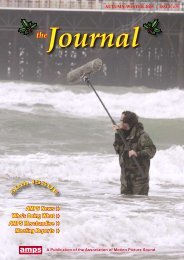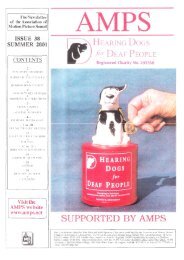Summer 2000 - The Association of Motion Picture Sound
Summer 2000 - The Association of Motion Picture Sound
Summer 2000 - The Association of Motion Picture Sound
Create successful ePaper yourself
Turn your PDF publications into a flip-book with our unique Google optimized e-Paper software.
THE NAGRA : "IT WILL RECORD"<br />
A personal tribute to Stephan Kudelski<br />
When writing the citation for Stephan Kudelski's<br />
AMPS' Honorary Fellowship Award, I became<br />
aware, as far as I could ascertain, that no sound<br />
man or woman who used Nagras to make their<br />
living, had ever paid public tribute to him. So I,<br />
being one <strong>of</strong> those guilty <strong>of</strong> this appalling<br />
oversight, decided I'd better make some sort <strong>of</strong><br />
attempt to correct the situation.<br />
For neigh on 35 years,<br />
worldwide, Nagras were taken<br />
for granted as the best and most<br />
reliable way <strong>of</strong> recording motion<br />
picture production sound on<br />
location and in the studio, be it<br />
for features, commercials,<br />
documentaries or TV movies.<br />
From 1961, by using a Nagra,<br />
good quality synch sound could<br />
be recorded wherever a 16 or<br />
35mm camera could go. <strong>The</strong><br />
days <strong>of</strong> sound trucks with<br />
sprocketed film channels and<br />
banks <strong>of</strong> heavv dutv batteries<br />
were numbered.<br />
<strong>The</strong> documentary and short<br />
film industry were first to see the<br />
Nagra' s potential. Documentary<br />
film maker Derrick Knieht<br />
speaking recently <strong>of</strong><br />
documentary film making in the 1950s said that<br />
they couldn't afford synch sound and for their<br />
tracks, had to make do with a few library sound<br />
FX. <strong>The</strong> Nagra changed all that. Very soon after<br />
it's introduction, on documentaries and TV current<br />
affairs programmes, there was no silent shot -<br />
sound turned on everything. A sound recordist<br />
with Nagra slung over the shoulder, a good<br />
microphone, handheld or on a short pole, could<br />
cover everything in camera range. Documentary<br />
crews working together became extremely skilled<br />
in this style <strong>of</strong> shooting, never missing a turnover<br />
or a clapper. <strong>Sound</strong> for documentaries became<br />
'realistic' rather than 'creative' as it had had to be in<br />
the past due to the lack <strong>of</strong> truly portable camera and<br />
sound equipment.<br />
<strong>The</strong> introduction <strong>of</strong> the Nagra as a recorder for<br />
recording synch sound was not greeted with loud<br />
acclaim in the feature film industry. <strong>The</strong> sound<br />
departments <strong>of</strong> the major studios were not<br />
convinced thatll4' tape was suitable forfeature<br />
film production. <strong>The</strong> Lrevers Rich Synchro Pulse<br />
1/4" method for synch recording had been tried but<br />
had a wobbly reputation, due mainly to crews<br />
forgetting to plug up the synch cable. [t was used<br />
by TV film units reasonably successfully but in the<br />
feature studios relegated to location use only,<br />
where the then policy was to post synch all sound<br />
recorded outside the walls <strong>of</strong> a sound stage.<br />
<strong>The</strong> 60s saw an increase in the number <strong>of</strong><br />
independent producers setting up to make feature<br />
films on location without using facilities from the<br />
major studios. <strong>The</strong> Nagra came into its own.<br />
Facilities companies were set up to hire out camera<br />
and sound equipment. But the astute freelance<br />
sound mixers splashed out and bought their own<br />
gear. <strong>The</strong> outlay for a Nagra 3, AKG or Sennheiser<br />
mics plus cables and a few other<br />
accessories was not prohibitive,<br />
especially when compared with<br />
Westrex sprocketed ma gnetic<br />
channels and WE or RCA<br />
microphones as used by the<br />
major studios. With his own<br />
equipment the mixer could know<br />
the gear was in top condition and<br />
also be adding to his income the<br />
rental charge negotiated with the<br />
production company. Work for<br />
freelance crews at that time was<br />
reasonably plentiful for the good<br />
guys, thus the gear was an<br />
excellent investment, rental<br />
earnings being better than the<br />
going interest rates form banks<br />
and buildins societies.<br />
<strong>The</strong> economical advantages to<br />
both producers and equipment<br />
owners were considerable but the<br />
technical advantages were phenomenal - high<br />
quality sound, extreme portability, astoundin g<br />
reliability, simplicity <strong>of</strong> operation, and all at a<br />
reasonable cost.<br />
Very soon all documentary and independent<br />
features were being recorded on Nagras but it took<br />
at least five years before the major studios sound<br />
departments accepted the Nagra. Besides technical<br />
apprehensions there were crewing worries, not by<br />
the union, but sound camera operators feared that<br />
producers would question their necessity.<br />
Freelance sound mixer Dudley Plummer who<br />
took delivery <strong>of</strong> his first Nagra 3 in 1961, probably<br />
the first in the UK, told me how on a job that took<br />
him to Shepperton Studios, covering a film star<br />
pr<strong>of</strong>ile story, one <strong>of</strong> the resident floor mixers<br />
snarled at him with curled lip "Oh, you're one <strong>of</strong><br />
those chaps who carries it all on your back and<br />
needs a 1 ton generator to get a 50 cycle pulse!".<br />
Many reputable sound people said the Nagra would<br />
never get anywhere. How wrong they were.<br />
From the start <strong>of</strong> my motion picture sound<br />
recording career I have always been interested in<br />
'natural sound'. Fortunately in my first job with the<br />
New Zealand National Film Unit during WWII, I<br />
was given every encouragement to pursue that<br />
interest by providing realistic sound effects tracks<br />
for many <strong>of</strong> the'Weekly Review' items and<br />
documentary films produced during the seven years<br />
that I was employed there.<br />
8


